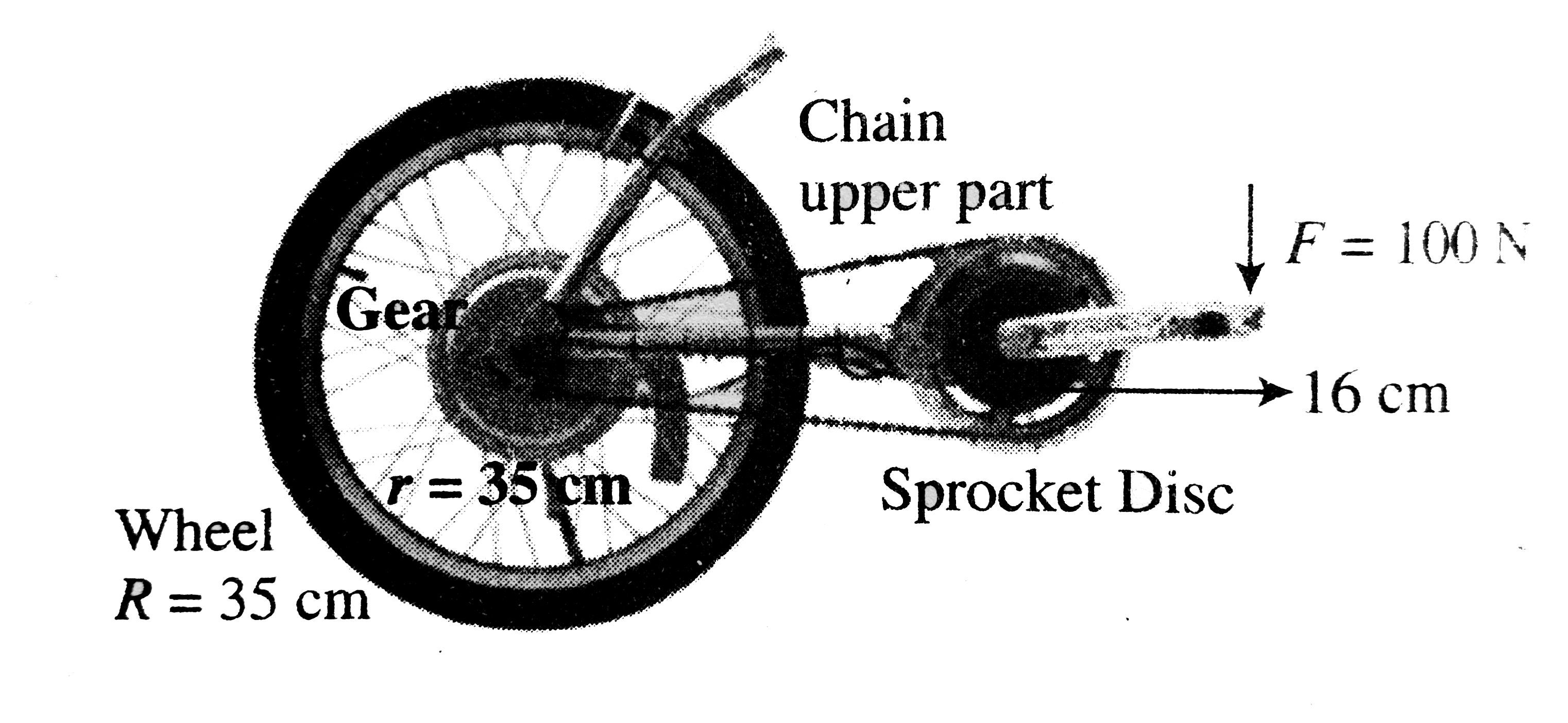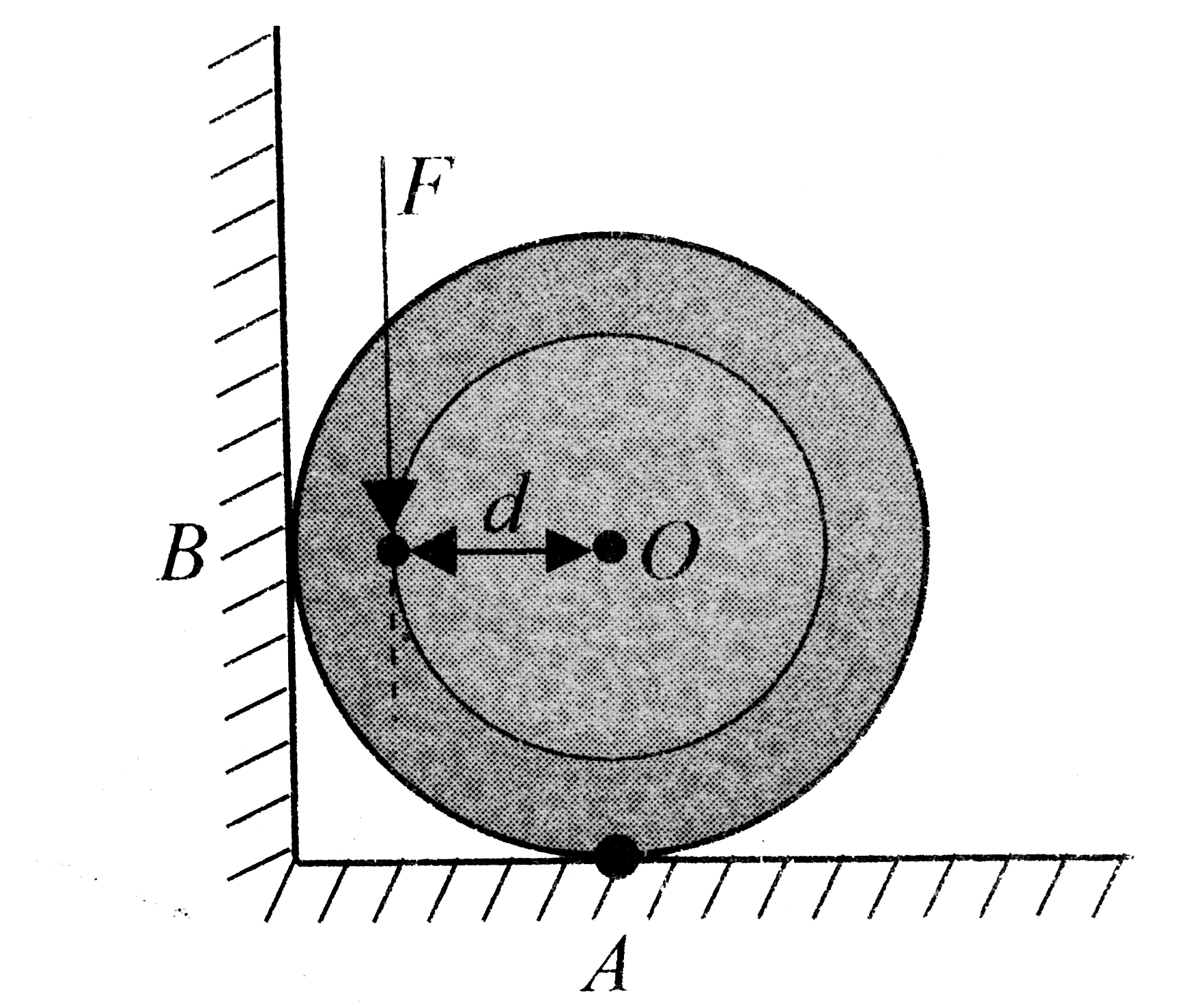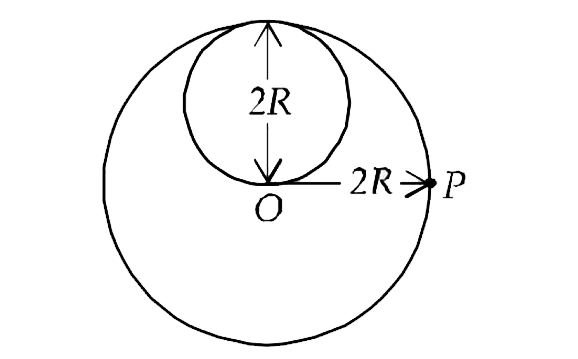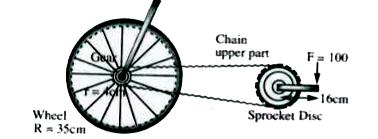A bicycle has pedal rods of length 16cm connected to sprocketed disc of radius 10cm. The bicycle wheels are 70cm in diameter and the chain runs over a gear of radius 4cm. The speed of the cycle is constant and the cyclist applies 100N for, that is always perpendicular to the pedal rod, as shown in figure. Assume tension in the lower part of chain is negligible. The cyclist is peddling at a constant rate of two revolutions per second. Assume that the force applied by other foot is zero when one foot is exerting 100N force. Neglect friction within cycle parts and the rolling friction.

The net force of the friction on the rear wheel due to the road is:
100N
62N
32.6N
18.3N
The correct Answer is:D
As ∑τ=0
160N×4cmf×35cm
f=160×4cm35cm=18.3N
Topper's Solved these Questions
- BOOK - CENGAGE PHYSICSCHAPTER - RIGID BODY DYNAMICS 1EXERCISE - Integer11videos
RIGID BODY DYNAMICS 1
- BOOK - CENGAGE PHYSICSCHAPTER - RIGID BODY DYNAMICS 1EXERCISE - Multiple Correct9videos
RIGID BODY DYNAMICS 1
- BOOK - CENGAGE PHYSICSCHAPTER - PROPERTIES OF SOLIDS AND FLUIDSEXERCISE - INTEGER_TYPE2videos
PROPERTIES OF SOLIDS AND FLUIDS
- BOOK - CENGAGE PHYSICSCHAPTER - RIGID BODY DYNAMICS 2EXERCISE - Interger2videos
RIGID BODY DYNAMICS 2
Similar Questions
A solid cylinder with r=0.1m and mass M=2kg is placed such that it is in contact with the vertical and a horizontal surface as shown in Fig. The coefficient of friction is μ=(1/3) for both the surfaces. Find the distance (in CM) from the centre of the cylinder at .which a force F=40N should be applied vertically so that the cylinder just starts rotating in anticlockwise direction.
 01:35View Solution
01:35View SolutionA rigid body is in pure rotation, that is, undergoing fixed axis rotation. Then which of the following statement(s) are true?
02:01View SolutionTwo soap bubbles A and B are kept in a closed chamber where the air is maintained at pressure 8N/m2.The radii of bubbles A and B are 2cm and 4cm, respectively. Surface tension of the soap-water used to make bubbles is 0.04N/m. Find tha ratio nB/nA, where nA and nB are the number of moles of air in bubbles A and B, respectively. [Neglect the effect of gravity.]
02:27View SolutionA lamina is made by removing a small disc of diameter 2R from a bigger disc of uniform mass density and radius 2R, as shown in the figure. The moment of inertia of this lamina about axes passing though O and P is IOandIP respectively. Both these axes are perpendicular to the plane of the lamina. The ratio IPIO ot the nearest integer is
 03:44View Solution
03:44View SolutionA bicycle has pedal rods of length 16 cm connected to sprocketed disc of radius 10 cm . The bicycle wheels are 70 cm in diameter and the chain runs over a gear of radius 4cm . The speed of the cycle is constant and the cyclist applies 100 N for, that is always perpendicular to the pedal rod, as shown in figure. Assume tension in the lower part of chain is negligible. The cyclist is peddling at a constant rate of two revolutions per second. Assume that the force applied by other foot is zero when one foot is exerting 100 N force. Neglect friction within cycle parts and the rolling friction. The tension in the upper portion of the chain is equal to
View SolutionA bicycle has pedal rods of length 16 cm connected to sprocketed disc of radius 10 cm . The bicycle wheels are 70 cm in diameter and the chain runs over a gear of radius 4cm . The speed of the cycle is constant and the cyclist applies 100 N for, that is always perpendicular to the pedal rod, as shown in figure. Assume tension in the lower part of chain is negligible. The cyclist is peddling at a constant rate of two revolutions per second. Assume that the force applied by other foot is zero when one foot is exerting 100 N force. Neglect friction within cycle parts and the rolling friction. Net torque on the rear wheel of the bicycle is equal to
View SolutionA bicycle has pedal rods of length 16 cm connected to sprocketed disc of radius 10 cm . The bicycle wheels are 70 cm in diameter and the chain runs over a gear of radius 4cm . The speed of the cycle is constant and the cyclist applies 100 N for, that is always perpendicular to the pedal rod, as shown in figure. Assume tension in the lower part of chain is negligible. The cyclist is peddling at a constant rate of two revolutions per second. Assume that the force applied by other foot is zero when one foot is exerting 100 N force. Neglect friction within cycle parts and the rolling friction. The power delivered by the cyclist is equal to
05:12View SolutionA bicycle has pedal rods of length 16 cm connected to sprocketed disc of radius 10 cm . The bicycle wheels are 70 cm in diameter and the chain runs over a gear of radius 4cm . The speed of the cycle is constant and the cyclist applies 100 N for, that is always perpendicular to the pedal rod, as shown in figure. Assume tension in the lower part of chain is negligible. The cyclist is peddling at a constant rate of two revolutions per second. Assume that the force applied by other foot is zero when one foot is exerting 100 N force. Neglect friction within cycle parts and the rolling friction. The speed of the bicycle is
View SolutionThe number of teeth in the crank wheel and free wheel of a bicycle, connected by a chain are 48 and 24, respectively. Their diameters are 20 cm and 10 cm, respectively. The radius of the rear wheel to which the free wheel is fixed coaxially is 10 times that of the free wheel. If a cyclist pedals the bicycle at two rotations per second, find the speed of the cyclist.
View Solutionकिसी बाइसकिल के पहिये की त्रिज्या 70 सेमि है| बताईये की पहिये के एक लगाने पर उसका केंद्र कितनी दुरी चलेगी?
03:23View SolutionA cyclist rides up a hill at a constant velocity. Determine the power developed by the cyclist if the length of the connecting rod of the pedal is l = 25 cm, the time of revolution of the rod is t = 2 s and the mean force exerted by his foot on the pedal is F = 15 kg.
02:13View SolutionPassage - I
A bicycle has pedal rods of length 16 cm connected to a sproketed disc of radius 10cm. The bicycle wheels are 70 cm in diameter and the chain runs over a gear of radius 4 cm. The speed of the cycle is constant and the cyclist applies 100 N force that is always perpendicular to the pedal rod, as shown, Assume tension in the lower part chain negligible. The cyclist is pedding at a constant rate of two revolutions per second. Assume that the force applied by other foot is zero when one foot is exerting 100 N force. Ngelect friction within cycle parts & the rolling friction.

The tension in the upper portion of the chain is equal to03:26View SolutionPassage - I A bicycle has pedal rods of length 16 cm connected to a sproketed disc of radius 10cm. The bicycle wheels are 70 cm in diameter and the chain runs over a gear of radius 4 cm. The speed of the cycle is constant and the cyclist applies 100 N force that is always perpendicular to the pedal rod, as shown, Assume tension in the lower part chain negligible. The cyclist is pedding at a constant rate of two revolutions per second. Assume that the force applied by other foot is zero when one foot is exerting 100 N force. Ngelect friction within cycle parts & the rolling friction. The speed of the bicycle is
03:22View SolutionA bicycle has pedal rods of length 16 cm connected to sprocketed disc of radius 10 cm . The bicycle wheels are 70 cm in diameter and the chain runs over a gear of radius 4cm . The speed of the cycle is constant and the cyclist applies 100 N for, that is always perpendicular to the pedal rod, as shown in figure. Assume tension in the lower part of chain is negligible. The cyclist is peddling at a constant rate of two revolutions per second. Assume that the force applied by other foot is zero when one foot is exerting 100 N force. Neglect friction within cycle parts and the rolling friction. The tension in the upper portion of the chain is equal to
02:07View SolutionA bicycle has pedal rods of length 16cm connected to sprocketed disc of radius 10cm. The bicycle wheels are 70cm in diameter and the chain runs over a gear of radius 4cm. The speed of the cycle is constant and the cyclist applies 100N for, that is always perpendicular to the pedal rod, as shown in figure. Assume tension in the lower part of chain is negligible. The cyclist is peddling at a constant rate of two revolutions per second. Assume that the force applied by other foot is zero when one foot is exerting 100N force. Neglect friction within cycle parts and the rolling friction.

The power delivered by the cyclist is equal to02:20View Solution

